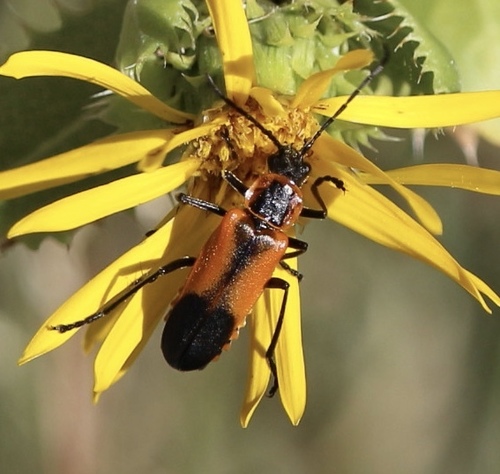
Written by Erica Krimmel.
This month let’s celebrate a friendly beetle that you’ve likely encountered, perhaps out on a hike or at home in your garden: the Soldier Beetle, i.e., a member of the family Cantharidae. These insects are globally distributed and their long antennae and striking colors–often red, orange, or yellow contrasting with black or brown–make them easily recognizable. The common name “Soldier Beetle” comes from these contrasting colors, which reminded early naturalists of the British Army’s red coat uniform.
The iDigBio Portal has 30,469 records of specimens identified as being in the family Cantharidae. This might seem like a lot, but given how taxonomically diverse and geographically distributed this family is, even tens of thousands of specimens don’t provide a full picture. Over the last decade, entomology collections in the United States have exponentially expanded their efforts to digitize insect and other arthropod specimen data, but we have a long way to go! Analysis by Cobb et al. (2019) found that, on average, the number of specimens digitized per arthropod species is 97. Again, that might seem like a lot until you learn that chordates (animals with backbones) have an average of 2584 specimens digitized per species.

Adult soldier beetles are frequently found on flowering plants, where they are feeding on pollen and nectar. Meanwhile, larvae are predaceous and typically less noticeable to humans, as they dwell on the ground in leaf litter or other debris. Curious about what species of plants soldier beetles like to feed on? The Global Biotic Interactions (GloBI) portal searches across multiple data sources, including specimen records like those shared on iDigBio, to help answer that question! Check out the plant species that GloBI has found soldier beetles in the genus Cantharis feeding on.
In addition to being widely distributed today, soldier beetles have a rich paleontological history. Recently, a fossil insect digitization project at the Natural History Museum of Los Angeles County resulted in the description of several new Cantharid species (Fanti and Walker, 2019). The type specimens for these species were collected by Georg Staz, a school teacher in pre-WWII Germany, from the Rott Formation near the present-day town of Hennef in Rhineland. These beetles were alive during the Oligocene, approximately 24 million years ago, at which time the area was a shallow lake. They were fossilized via compression in a finely laminated shale, and this process preserved very fine details in their anatomical structure. Through imaging techniques including focus stacking and microscopy, collections staff were able to reproduce this level of detail digitally, allowing the new species to be described from the images rather than the physical specimens. Physical specimens will always be essential to taxonomy and systematics, but this is an example of how digitization can facilitate access to collections in exciting new ways.

Photo credits
-
A Chauliognathus limbicollis showing off its striking colors. Observed in Buffalo Springs, TX by Lena Zappia, https://www.inaturalist.org/photos/51958804 (CC BY-NC).
-
Digitized specimen of Chauliognathus pensylvanicus (UMNH ENT 0043812) collected in 1925. Record citation: Entomology Collection at the Natural History Museum of Utah. Occurrence dataset accessed via iDigBio.org on 2021-07-02. https://www.idigbio.org/portal/records/c957266e-0c3b-4230-8741-eeb237f079aa
-
Holotype of Cantharis (Cantharis) bradburyi Fanti & Walker, 2019 (LACMIP 2533.3451). Record citation: Hendy A, Walker L, Mertz W (2020). LACM Invertebrate Paleontology. Version 1.9. Natural History Museum of Los Angeles County. Occurrence dataset https://doi.org/10.15468/6nxzen accessed via GBIF.org on 2021-07-02. https://www.gbif.org/occurrence/1950904800.
References
Cobb NS, Gall LF, Zaspel JM, Dowdy NJ, McCabe LM, Kawahara AY. 2019. Assessment of North American arthropod collections: prospects and challenges for addressing biodiversity research. PeerJ 7:e8086 https://doi.org/10.7717/peerj.8086
Fanti F, Walker LJ. 2019. Fossil Soldier Beetles (Coleoptera: Cantharidae) of the Georg Statz Collection from the Oligocene Rott Formation, Germany. Palaeoentomology 2(5): 491–504.




